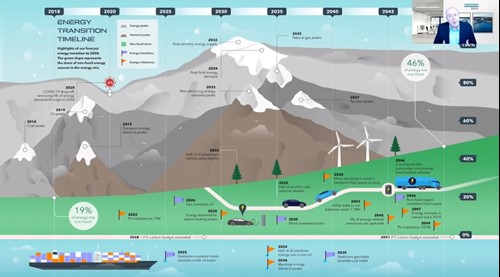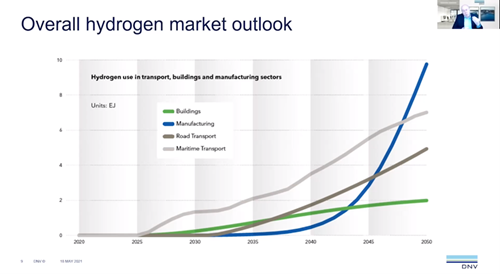News
H2Tech Solutions '21: DNV VP explains H2's key role in energy transition
Opening Day 1 of H2Tech's H2Tech Solutions virtual conference, Graham Bennett, Vice Present and Head of Energy Transition at DNV, spoke about the recent growth of the hydrogen economy and what is different about hydrogen now versus the previous "false starts" for the hydrogen economy.
While it is important to see greater electrification from renewables to encourage a low-carbon economy, Bennett noted that there are more than 6,00 daily products in use around the world that are made from oil and gas, including many of the components used to build renewable energy infrastructure. "That molecular energy that we need today will still be needed tomorrow," Bennett said.
According to DNV's forecast, by 2050 only about 46% of the energy mix will be non-fossil, while 54% of the energy system will still be supported by hydrocarbons. Hydrogen will play a key role here, as it will help decarbonize the "gray" and "brown" molecular energy needed for feedstock and process heat.

The main drivers for introducing hydrogen as an energy carrier are seen in four key areas:
1. Decarbonization of heating (buildings)
2. Mobility applications (buses, trains, ferries and other maritime, passenger vehicles, etc.)
3. Valorization and storage of excess electricity from renewable, low-OPEX power
4. Decarbonization of heat in energy-intensive industry applications.
With respect to overall hydrogen demand, government policy and investment appetite will encourage a buildup in hydrogen demand starting in 2025 that is expected to increase rapidly from 2035–2040. Beyond 2040, hydrogen production at scale—and the demand to match—will be seen. DNV's forecast calls for 24 exajoules of energy (> 6% of global energy demand) to be provided by hydrogen in 2050; however, Bennett noted that this forecast is conservative and may change when DNV runs its forecast models again later this year.
Growth projections for different markets varies widely, with manufacturing and maritime transport emerging as the greatest potential markets. Maritime demand for hydrogen is expected tooutstrip that of road transport since electricity and batteries cannot be used for deep-sea, long-distance travel; therefore, hydrogen and hydrogen derivatives (green ammonia, e-methanol) primarily will be used to decarbonize maritime transportation.
DNV also believes that green hydrogen production will become cost-competitive with blue hydrogen production by the early 2030s. To this end, industrial clusters will play a key role in the development of both blue and green hydrogen production. Having supportive hydrogen and carbon capture, storage and utilization (CCUS) business models will be essential to avoid carbon offshoring.

The H2Tech Solutions virtual conference runs from 18–19 May. Please visit www.H2-TechSolutions.com to view the event agenda and register for live and on-demand access to the speaker presentations!

